- Using SafetyCulture
- Analytics
- What is Analytics?
What is Analytics?
Gain an overview of the Analytics feature in SafetyCulture.The article outlines the functionalities of the new Analytics experience, which we're continuously improving. If you have any feedback about the new Analytics experience, we'd love to hear them from you.
If you want to view analytics for the Training feature, learn more about the performance dashboard.
What is Analytics?
The Analytics feature allows you to view and analyze the data your team captures in SafetyCulture. You can create customizable dashboards, enabling you to make sense of your data to identify improvement opportunities and isolate trends.
With Analytics, you can create customized dashboards to effectively share relevant data across your organization. Within each dashboard, you can tailor the charts shown to help your team cut through the noise and quickly gain an understanding of key data sets.
Visualize your data
Focus on what's important by creating dashboards and charts that you can tailor depending on the data sets you want to analyze.
Dashboards
Once a dashboard is created and shared, it becomes available on the Analytics page. Each dashboard can contain multiple charts, which can be used to focus on a particular area of interest.
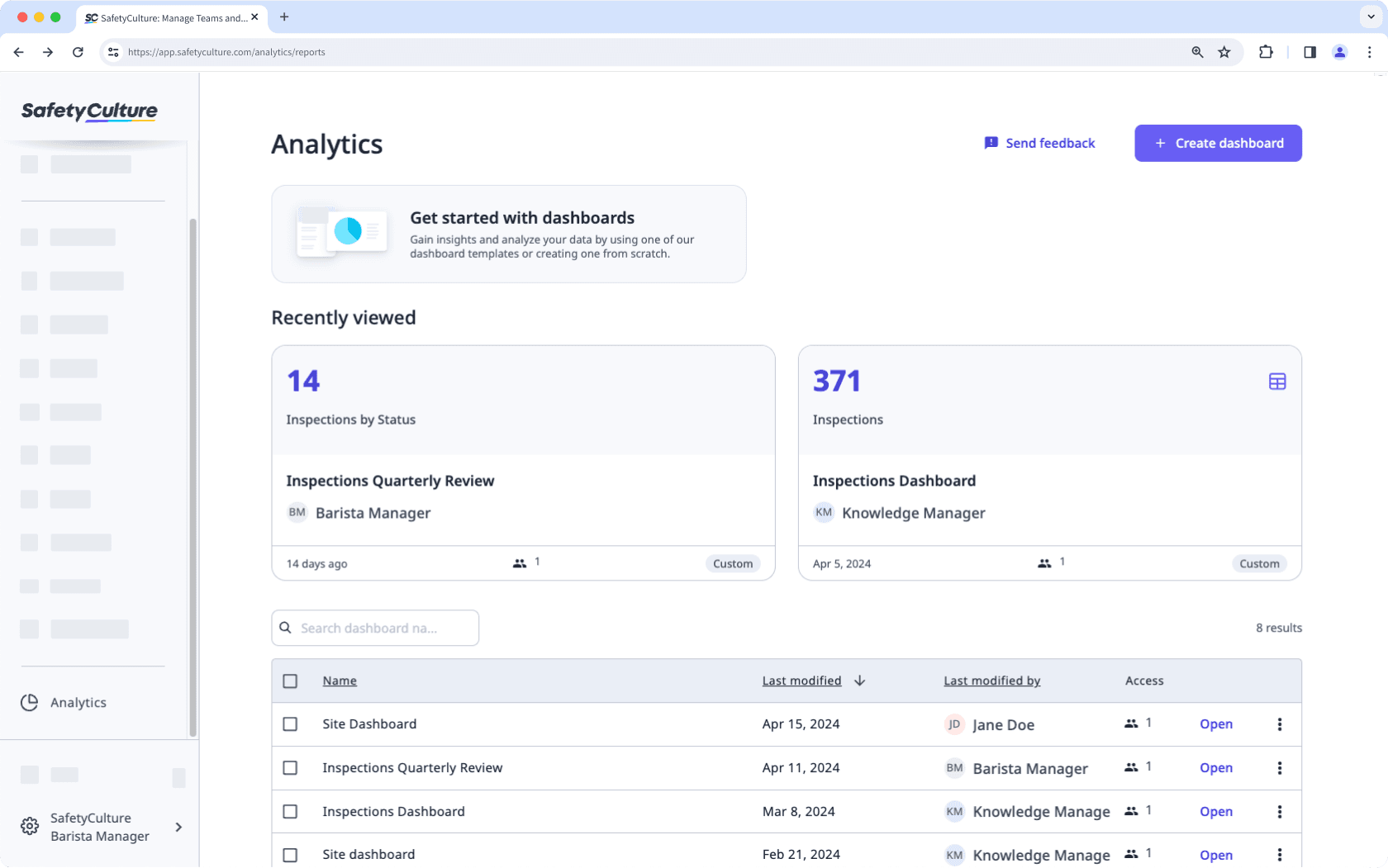
Charts
Analytics charts can be configured to ensure only relevant data is shared with your audience. There are multiple data visualization options available to allow you to convey your organization's data in the most suitable way.
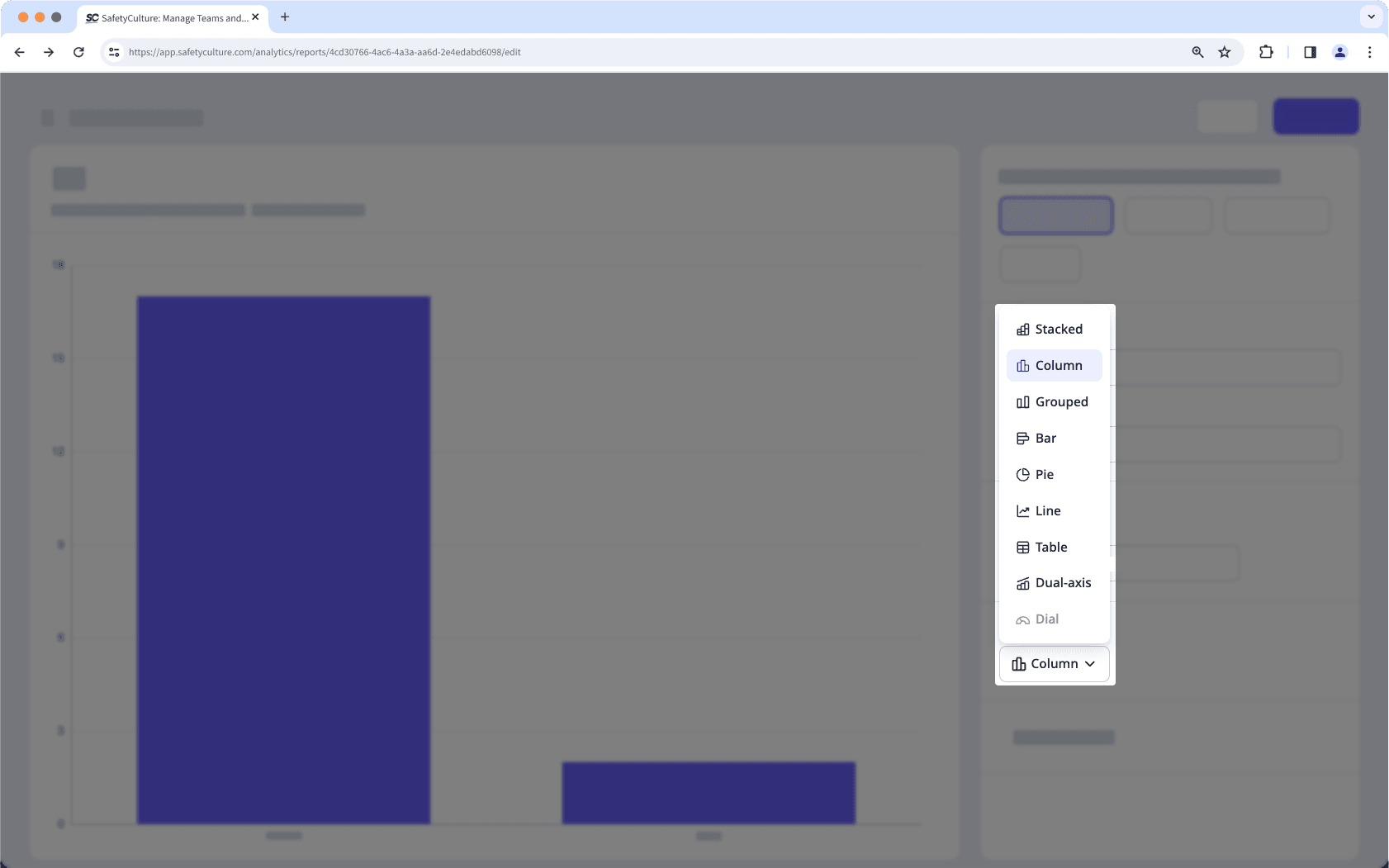
Measure your data
Refine your charts using metrics and attributes so you can easily identify and prioritize data sets for analysis depending on your needs.
Metrics
A metric is the measurement or calculation of data that's selected for a chart, such as inspection durations or the number of actions.
Attributes
An attribute is an element by which you can breakdown your metric to gain more insights. Attributes, such as inspection date, can be selected to group metrics in different ways.
Available chart metrics
The number of inspections created in the chosen period.
The average (arithmetic mean) duration of inspections conducted in the chosen period, denoted in hours and minutes. Inspections without a recorded duration are excluded.
The average (arithmetic mean) score of inspections conducted in the chosen period, as a percentage. Inspections without a recorded score are excluded.
The number of flagged responses from inspections conducted in the chosen period.
The number of inspections with flagged responses as a percentage of the total inspections conducted in the chosen period.
The percentage of inspections, including any archived inspections, completed in the chosen period.
For an accurate reflection of the completion rate, we recommend that you filter charts by the "Completed" and "Incomplete" statuses.
The number of times a response was selected in inspections in the chosen period.
The number of actions created in the chosen period.
The percentage of actions completed or moved to a closed status in the chosen period.
For an accurate reflection of the completion rate, we recommend that you filter the chart by all your action statuses.
A list of scheduled inspections in the chosen period.
Schedules you've created or been assigned to will appear in the chart drill-down. To view schedules created by or assigned to other users, you’ll need "Schedules: Manage" permission.
A list of completed scheduled inspections in the chosen period.
Schedules you've created or been assigned to will appear in the chart drill-down. To view schedules created by or assigned to other users, you’ll need "Schedules: Manage" permission.
The number of issues created in the chosen period.
Available chart attributes
The last user who edited an inspection.
The owner of an inspection. This is usually the user who started the inspection.
The site of an inspection, action, or issue.
The area of an inspection, action, or issue.
The region of an inspection, action, or issue.
The state of an inspection, action, or issue.
The country of an inspection, action, or issue.
The start date of an inspection.
The status of an inspection, action, or issue.
The template used to conduct an inspection.
The selected question from an inspection. This requires you to select the specific question.
The asset of an inspection or action.
The responses in a multiple choice response set. This attribute is only available to use with the Responses metric.
Groups and displays a breakdown of responses in a template structured by pages, sections, and questions, along with average scores.
This attribute is selected by default when the Responses table chart type is selected.
The creation date of an action or issue.
The priority of an action or issue.
The label of an action.
Groups scheduled inspections based on their start date. Only the current and next schedule windows are displayed.
Please note that you need "Schedules: Manage" permission to view schedules created by other users in your organization.
The schedule linked to an inspection.
Schedules you've created or been assigned to will appear in the chart drill-down. To view schedules created by or assigned to other users, you’ll need "Schedules: Manage" permission.
The type of an action.
The category of an issue.
Groups and displays a breakdown of pages, sections, and questions in a template, along with average scores for inspections conducted across a period of time.
This attribute can only be used with the "Average score" metric and "Timeline table" chart type.
Filter your data
A filter allows you to dive deeper into specific topics by limiting which data sets are shown. For example, the date filter can be used to focus on data from a specific date range.
Available dashboard filters
The date range to filter data by. Please note that you can only filter data for a maximum of 1 year at a time when using "Custom range".
Inspections, Actions, and Issues: Filters by the date an inspection, action, or issue was created.
Schedules: Filters scheduled inspections by the start date of the schedule window. For example, if a schedule is set to occur every 15th of the month, the schedules will be displayed as "January 15", "February 15", and so on.

The frequency to group data by based on when they were created.
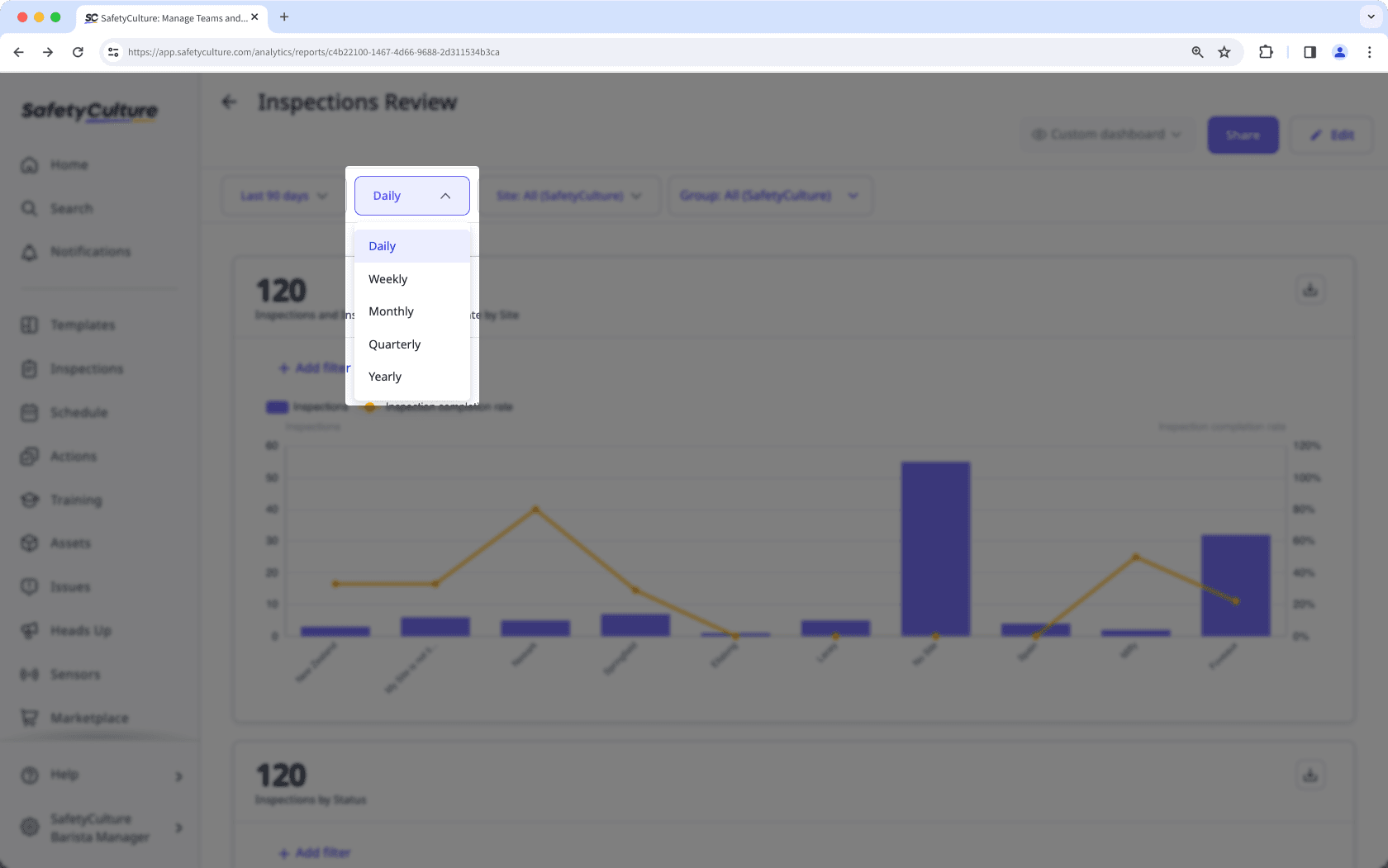
The site or level to filter data by.
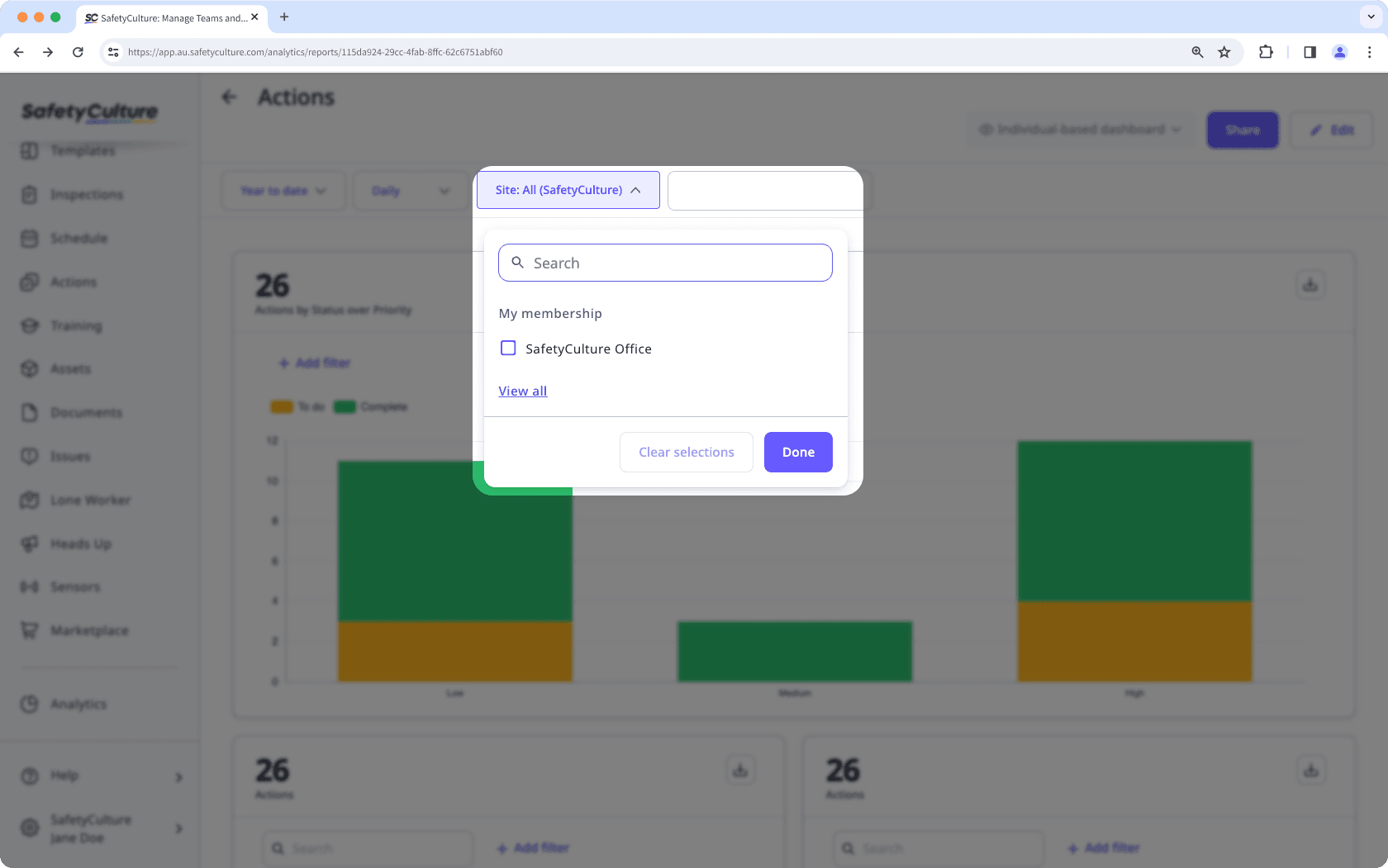
The group to filter data by. Depending on the metric that you've selected for a chart, the filter may work differently:
Inspections: Filters based on the last editor of the inspection. If multiple users have edited an inspection, the inspections are shown based on the last person who edited it, if they’re in the group you’re filtering by.
Actions and Schedules: Filters based on assignees. This works for both assigned to groups and individual users, where users in the group you’re filtering by will also be displayed.
Issues: Filters based on issue assignees, where issues assigned to users in the group you're filtering by will be displayed.
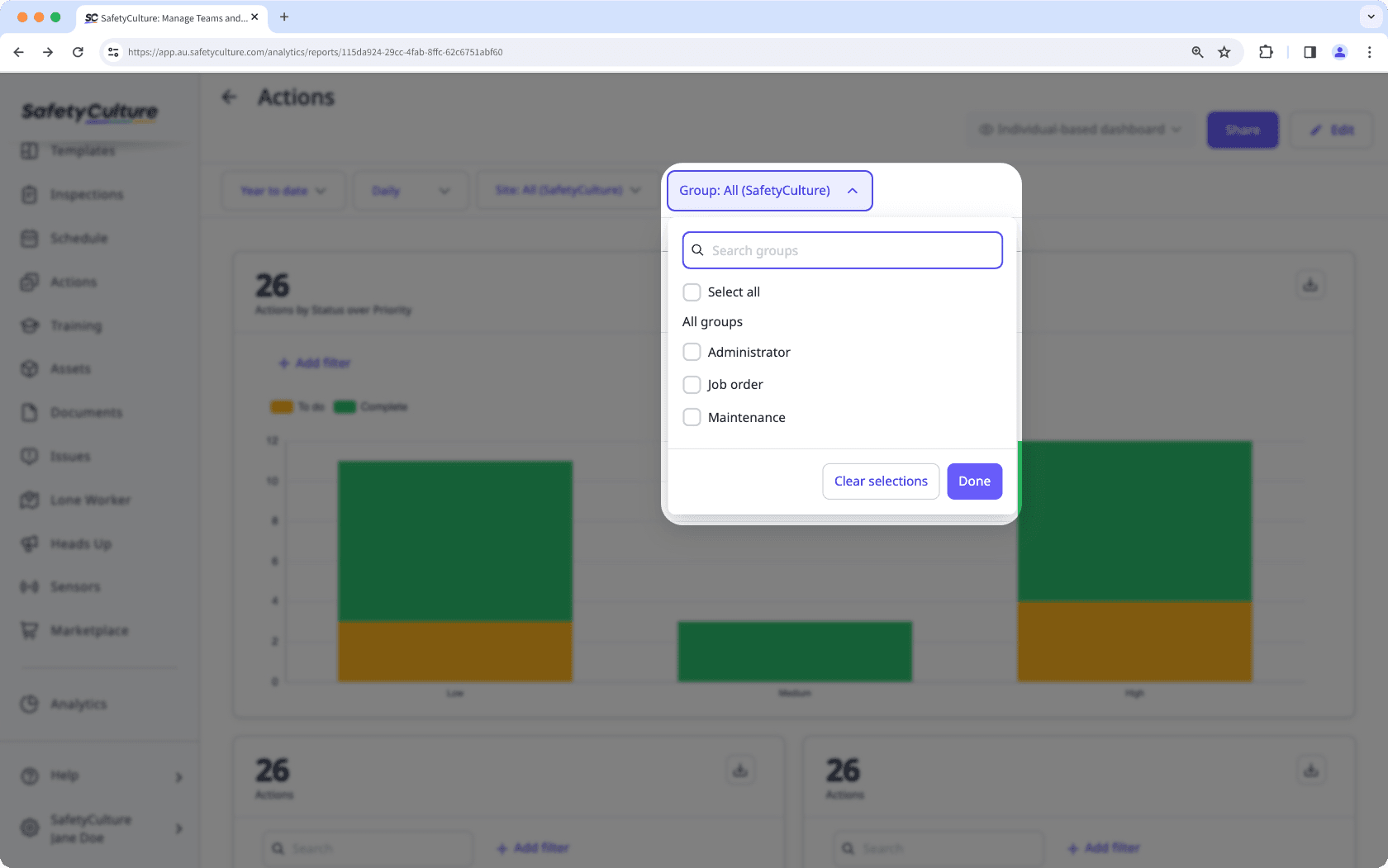
Available chart filters
The completion status of the inspection, action, or issue.
Filtering inspections by the "Archived" status will show inspections regardless of whether they’re complete or incomplete.
The template used to conduct the inspections.
The asset of an inspection or action.
Filtering by asset is only available when the "Asset type" filter isn't applied.
The selected type of asset.
Filtering by asset type is only available when the "Asset" filter isn't applied.
The response entered or selected in inspections.
The selected flagged responses in inspections. Flagged responses must be set up in your templates to capture data accurately. Please note that the flagged responses filter is only available in the Responses table chart types when tracking inspection responses.
The priority of the action or issue.
The label of an action.
The type of an action.
The schedule linked to an inspection.
Please note that you need "Schedules: Manage" permission to view schedules created by other users in your organization.
The category of the issue.
Dashboard sharing
Once you've configured your analytics dashboard to suit your use case, you can selectively share it with groups or give everyone in your organization visibility. Simply click Share while viewing your dashboard and selecting the relevant groups.
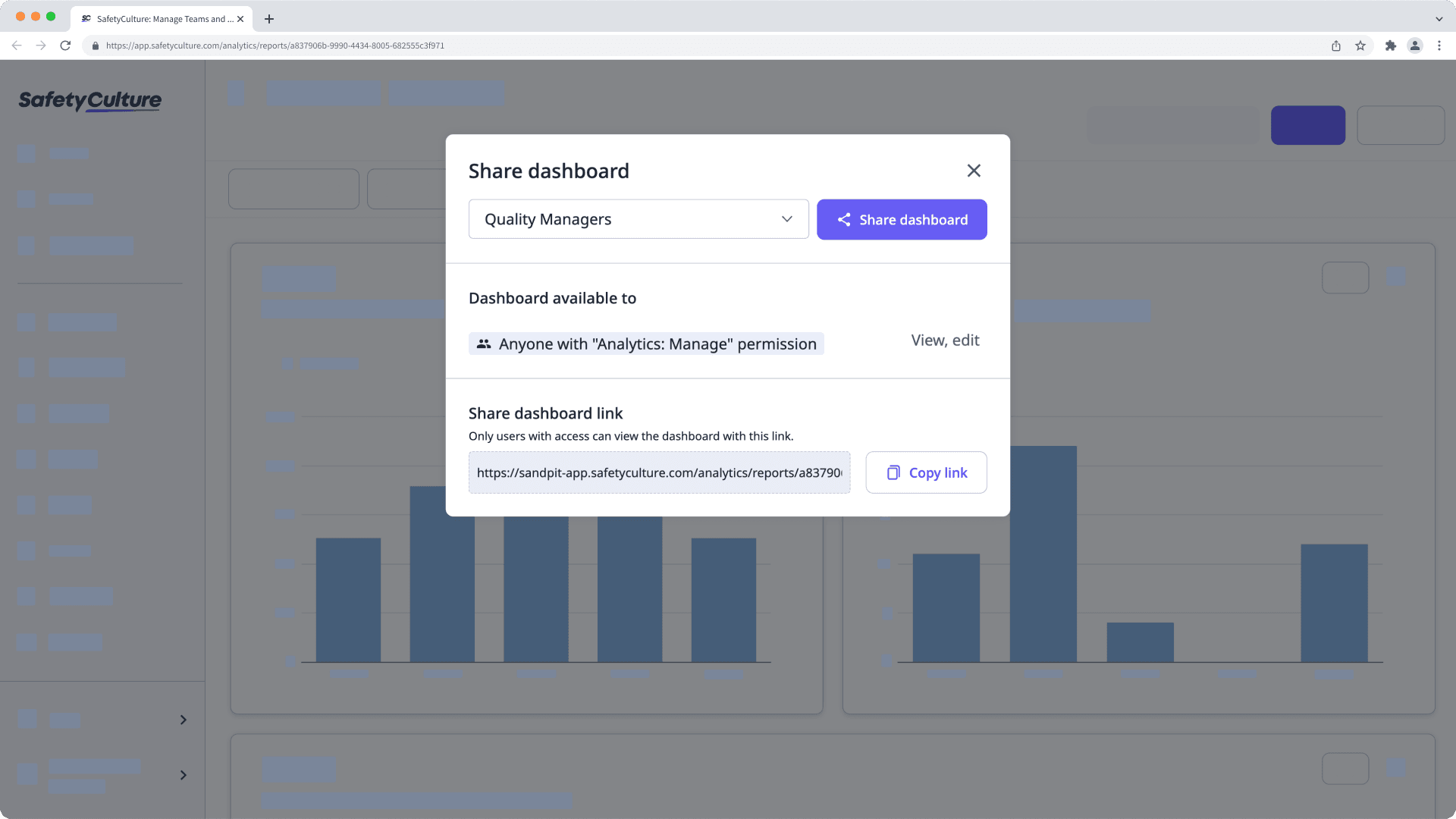
Take your data beyond SafetyCulture
Get the data you need in the format that works best for you. Download charts as images or CSV files for a quick overview, or bulk export different data types such as inspections, actions, issues, and schedules for deeper analysis. Whether you're reporting on team performance or tracking trends across sites, it's easy to share and work with your data outside the platform.
Was this page helpful?
Thank you for letting us know.